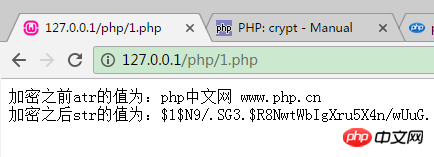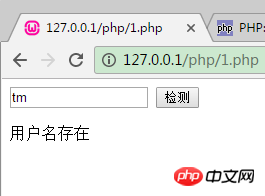 Backend Development
Backend Development
 PHP Tutorial
PHP Tutorial
 PHP encryption function—crypt() function encryption usage example
PHP encryption function—crypt() function encryption usage example
PHP encryption function—crypt() function encryption usage example
PHP encryption function—crypt() function encryption
Before introducing the encryption function, let us first introduce the principle of data encryption: it is to The file or data is processed according to a certain algorithm, making it an unreadable piece of code, usually called "ciphertext". Through this method, the purpose of protecting the data from illegal theft and reading is achieved!
The functions that can encrypt data in PHP mainly include: crypt(), md5() and sha1(), as well as the encryption extension libraries Mcrpyt and Mash. In this article, we first introduce the use of crpyt() function for encryption!
crypt() function can complete the one-way encryption function, which is a one-way string hash!
crypt() function syntax format is as follows:
string crypt ( string $str [, string $salt ] )
| Algorithm | salt length |
| CRYPT_STD_DES | 2-character (default) |
| CRYPT_EXT_DES | 9-character |
| CRYPT_MD5 | 12-character (starting with $1$) |
| CRYPT_BLOWFISH | 16-character (starting with $2$) |
Here is a note:
By default, PHP uses one or two characters of DES interference string , if the system uses MD5, then 12 characters will be used. You can check the length of the currently used interference string through the CRYPT_SALT_LENGTH variable!
crypt() function instance usage:
Let’s use an example below to make it clear to everyone. The specific code is as follows:
<?php
header("Content-Type:text/html; charset=utf-8");
$atr = "php中文网 www.php.cn"; //声明字符串变量$atr
echo "加密之前atr的值为:".$atr;
$atr1 = crypt($atr); //对变量$str 加密
echo "<br>加密之后str的值为:".$atr1; //输出加密后的变量
?>Output The results are as follows:

After executing the above example, keep refreshing the browser, you will find that the encryption results generated each time are different, so how to compare them Judging the encrypted data becomes a problem. The crypt() function is a one-way encryption, the ciphertext cannot be restored to plaintext, and the data after encryption is different each time. This is the problem that the salt parameter is to solve.
The crypt() function uses the salt parameter to encrypt the plaintext. When judging, the output information is encrypted again using the same salt parameter, and the judgment is made by comparing the results after the two encryptions!
The following example checks the input user name. The specific code is as follows:
<?php
header("Content-Type:text/html; charset=utf-8");
$link=mysqli_connect("localhost","root","");
$db_selected = mysqli_select_db($link,"my_db");
?>
<form name="form1" action="" method="post">
<input type="text" name="username" id="username" size="15">
<input type="submit" name="Submit" value="检测">
</form>
<?php
if(isset($_POST["username"])!=""){
$usr=crypt(isset($_POST["username"]),"tm"); //对用户名进行加密
$sql = "select * from tb_user where user = '".$usr."'";//生成查询语句
$rst = mysqli_query($link,$sql); //执行语句,返回结果集
if($rst){
echo "用户名存在";
}else{
echo "用户名可以使用";
}
}
?>The output result is as follows:

Next article we We will introduce how to use the MD5() function for encryption. For details, please read "PHP Encryption Function—md5() Function Encryption"!
[Related Recommendations]
1. Related topic recommendations: "PHP Encryption Function"
2.PHP Encryption Function—md5() function encryption example usage
3.PHP encryption function—Instance usage of sha1() function encryption
4.PHP encryption technology video tutorial
The above is the detailed content of PHP encryption function—crypt() function encryption usage example. For more information, please follow other related articles on the PHP Chinese website!

Hot AI Tools

Undresser.AI Undress
AI-powered app for creating realistic nude photos

AI Clothes Remover
Online AI tool for removing clothes from photos.

Undress AI Tool
Undress images for free

Clothoff.io
AI clothes remover

Video Face Swap
Swap faces in any video effortlessly with our completely free AI face swap tool!

Hot Article

Hot Tools

Notepad++7.3.1
Easy-to-use and free code editor

SublimeText3 Chinese version
Chinese version, very easy to use

Zend Studio 13.0.1
Powerful PHP integrated development environment

Dreamweaver CS6
Visual web development tools

SublimeText3 Mac version
God-level code editing software (SublimeText3)

Hot Topics
 1664
1664
 14
14
 1421
1421
 52
52
 1315
1315
 25
25
 1266
1266
 29
29
 1239
1239
 24
24
 Explain JSON Web Tokens (JWT) and their use case in PHP APIs.
Apr 05, 2025 am 12:04 AM
Explain JSON Web Tokens (JWT) and their use case in PHP APIs.
Apr 05, 2025 am 12:04 AM
JWT is an open standard based on JSON, used to securely transmit information between parties, mainly for identity authentication and information exchange. 1. JWT consists of three parts: Header, Payload and Signature. 2. The working principle of JWT includes three steps: generating JWT, verifying JWT and parsing Payload. 3. When using JWT for authentication in PHP, JWT can be generated and verified, and user role and permission information can be included in advanced usage. 4. Common errors include signature verification failure, token expiration, and payload oversized. Debugging skills include using debugging tools and logging. 5. Performance optimization and best practices include using appropriate signature algorithms, setting validity periods reasonably,
 Explain late static binding in PHP (static::).
Apr 03, 2025 am 12:04 AM
Explain late static binding in PHP (static::).
Apr 03, 2025 am 12:04 AM
Static binding (static::) implements late static binding (LSB) in PHP, allowing calling classes to be referenced in static contexts rather than defining classes. 1) The parsing process is performed at runtime, 2) Look up the call class in the inheritance relationship, 3) It may bring performance overhead.
 PHP Program to Count Vowels in a String
Feb 07, 2025 pm 12:12 PM
PHP Program to Count Vowels in a String
Feb 07, 2025 pm 12:12 PM
A string is a sequence of characters, including letters, numbers, and symbols. This tutorial will learn how to calculate the number of vowels in a given string in PHP using different methods. The vowels in English are a, e, i, o, u, and they can be uppercase or lowercase. What is a vowel? Vowels are alphabetic characters that represent a specific pronunciation. There are five vowels in English, including uppercase and lowercase: a, e, i, o, u Example 1 Input: String = "Tutorialspoint" Output: 6 explain The vowels in the string "Tutorialspoint" are u, o, i, a, o, i. There are 6 yuan in total
 What are PHP magic methods (__construct, __destruct, __call, __get, __set, etc.) and provide use cases?
Apr 03, 2025 am 12:03 AM
What are PHP magic methods (__construct, __destruct, __call, __get, __set, etc.) and provide use cases?
Apr 03, 2025 am 12:03 AM
What are the magic methods of PHP? PHP's magic methods include: 1.\_\_construct, used to initialize objects; 2.\_\_destruct, used to clean up resources; 3.\_\_call, handle non-existent method calls; 4.\_\_get, implement dynamic attribute access; 5.\_\_set, implement dynamic attribute settings. These methods are automatically called in certain situations, improving code flexibility and efficiency.
 PHP and Python: Comparing Two Popular Programming Languages
Apr 14, 2025 am 12:13 AM
PHP and Python: Comparing Two Popular Programming Languages
Apr 14, 2025 am 12:13 AM
PHP and Python each have their own advantages, and choose according to project requirements. 1.PHP is suitable for web development, especially for rapid development and maintenance of websites. 2. Python is suitable for data science, machine learning and artificial intelligence, with concise syntax and suitable for beginners.
 PHP in Action: Real-World Examples and Applications
Apr 14, 2025 am 12:19 AM
PHP in Action: Real-World Examples and Applications
Apr 14, 2025 am 12:19 AM
PHP is widely used in e-commerce, content management systems and API development. 1) E-commerce: used for shopping cart function and payment processing. 2) Content management system: used for dynamic content generation and user management. 3) API development: used for RESTful API development and API security. Through performance optimization and best practices, the efficiency and maintainability of PHP applications are improved.
 PHP: A Key Language for Web Development
Apr 13, 2025 am 12:08 AM
PHP: A Key Language for Web Development
Apr 13, 2025 am 12:08 AM
PHP is a scripting language widely used on the server side, especially suitable for web development. 1.PHP can embed HTML, process HTTP requests and responses, and supports a variety of databases. 2.PHP is used to generate dynamic web content, process form data, access databases, etc., with strong community support and open source resources. 3. PHP is an interpreted language, and the execution process includes lexical analysis, grammatical analysis, compilation and execution. 4.PHP can be combined with MySQL for advanced applications such as user registration systems. 5. When debugging PHP, you can use functions such as error_reporting() and var_dump(). 6. Optimize PHP code to use caching mechanisms, optimize database queries and use built-in functions. 7
 PHP vs. Python: Understanding the Differences
Apr 11, 2025 am 12:15 AM
PHP vs. Python: Understanding the Differences
Apr 11, 2025 am 12:15 AM
PHP and Python each have their own advantages, and the choice should be based on project requirements. 1.PHP is suitable for web development, with simple syntax and high execution efficiency. 2. Python is suitable for data science and machine learning, with concise syntax and rich libraries.



